HR Report: Individual, Team and Organisational Development at M&S
VerifiedAdded on 2020/07/23
|15
|4406
|87
Report
AI Summary
This report analyzes the development of individuals, teams, and organizations, focusing on the role of Human Resource Management (HRM). It begins with an introduction to the importance of training and development in modern organizations, using Marks & Spencer (M&S) as a case study. Task 1 identifies essential professional knowledge, skills, and behaviors for HR professionals, including communication, problem-solving, decision-making, and monitoring. Task 2 involves a personal audit of an HR manager, assessing strengths, weaknesses, and development opportunities. Task 3 differentiates between individual and organizational learning, highlighting their objectives and benefits. Task 4 discusses the contribution of high-performance working to employee engagement and competitive advantages. Finally, Task 5 examines different approaches to performance management. The report concludes with a summary of key findings and recommendations for improving HR practices within organizations.
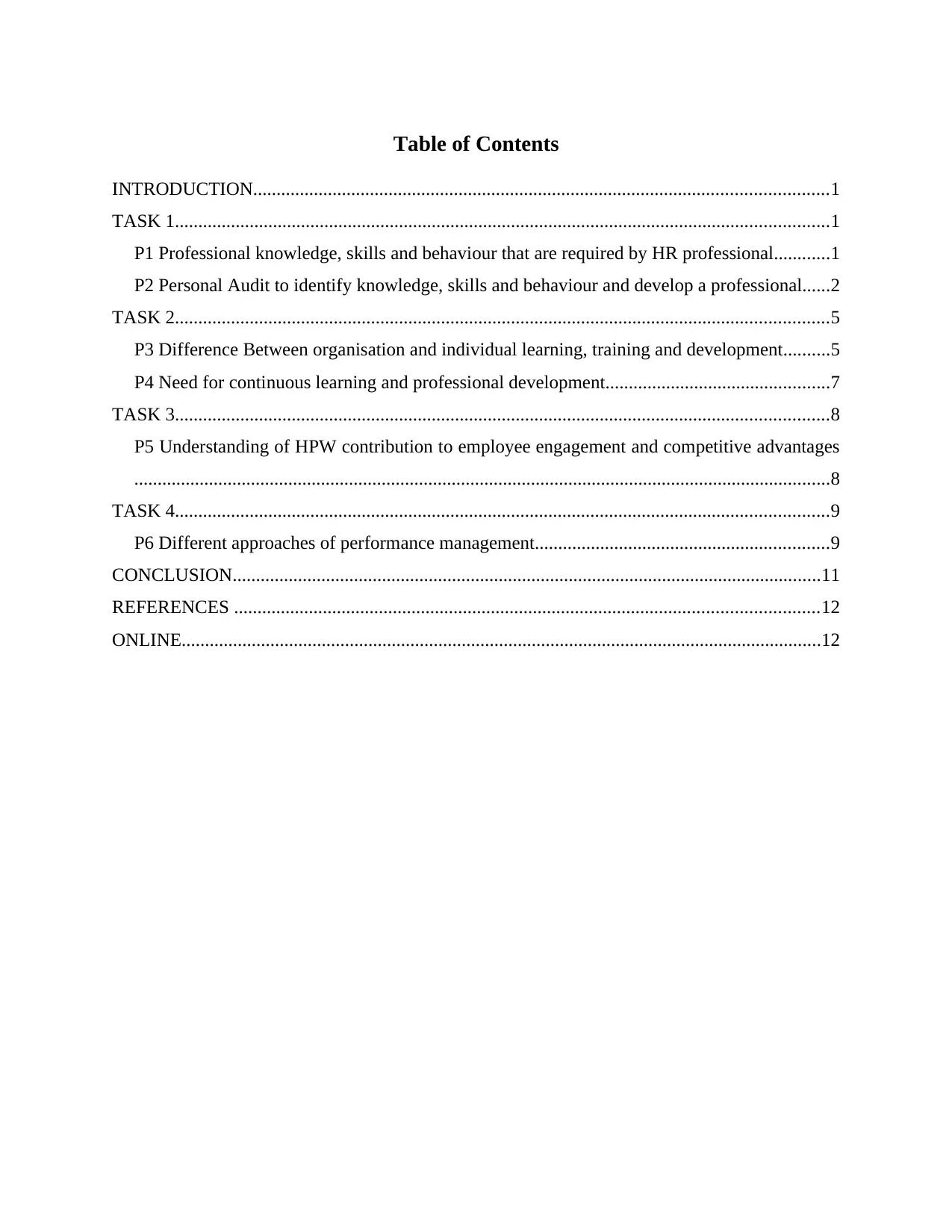
Table of Contents
INTRODUCTION...........................................................................................................................1
TASK 1............................................................................................................................................1
P1 Professional knowledge, skills and behaviour that are required by HR professional............1
P2 Personal Audit to identify knowledge, skills and behaviour and develop a professional......2
TASK 2............................................................................................................................................5
P3 Difference Between organisation and individual learning, training and development..........5
P4 Need for continuous learning and professional development................................................7
TASK 3............................................................................................................................................8
P5 Understanding of HPW contribution to employee engagement and competitive advantages
.....................................................................................................................................................8
TASK 4............................................................................................................................................9
P6 Different approaches of performance management...............................................................9
CONCLUSION..............................................................................................................................11
REFERENCES .............................................................................................................................12
ONLINE.........................................................................................................................................12
INTRODUCTION...........................................................................................................................1
TASK 1............................................................................................................................................1
P1 Professional knowledge, skills and behaviour that are required by HR professional............1
P2 Personal Audit to identify knowledge, skills and behaviour and develop a professional......2
TASK 2............................................................................................................................................5
P3 Difference Between organisation and individual learning, training and development..........5
P4 Need for continuous learning and professional development................................................7
TASK 3............................................................................................................................................8
P5 Understanding of HPW contribution to employee engagement and competitive advantages
.....................................................................................................................................................8
TASK 4............................................................................................................................................9
P6 Different approaches of performance management...............................................................9
CONCLUSION..............................................................................................................................11
REFERENCES .............................................................................................................................12
ONLINE.........................................................................................................................................12
Paraphrase This Document
Need a fresh take? Get an instant paraphrase of this document with our AI Paraphraser
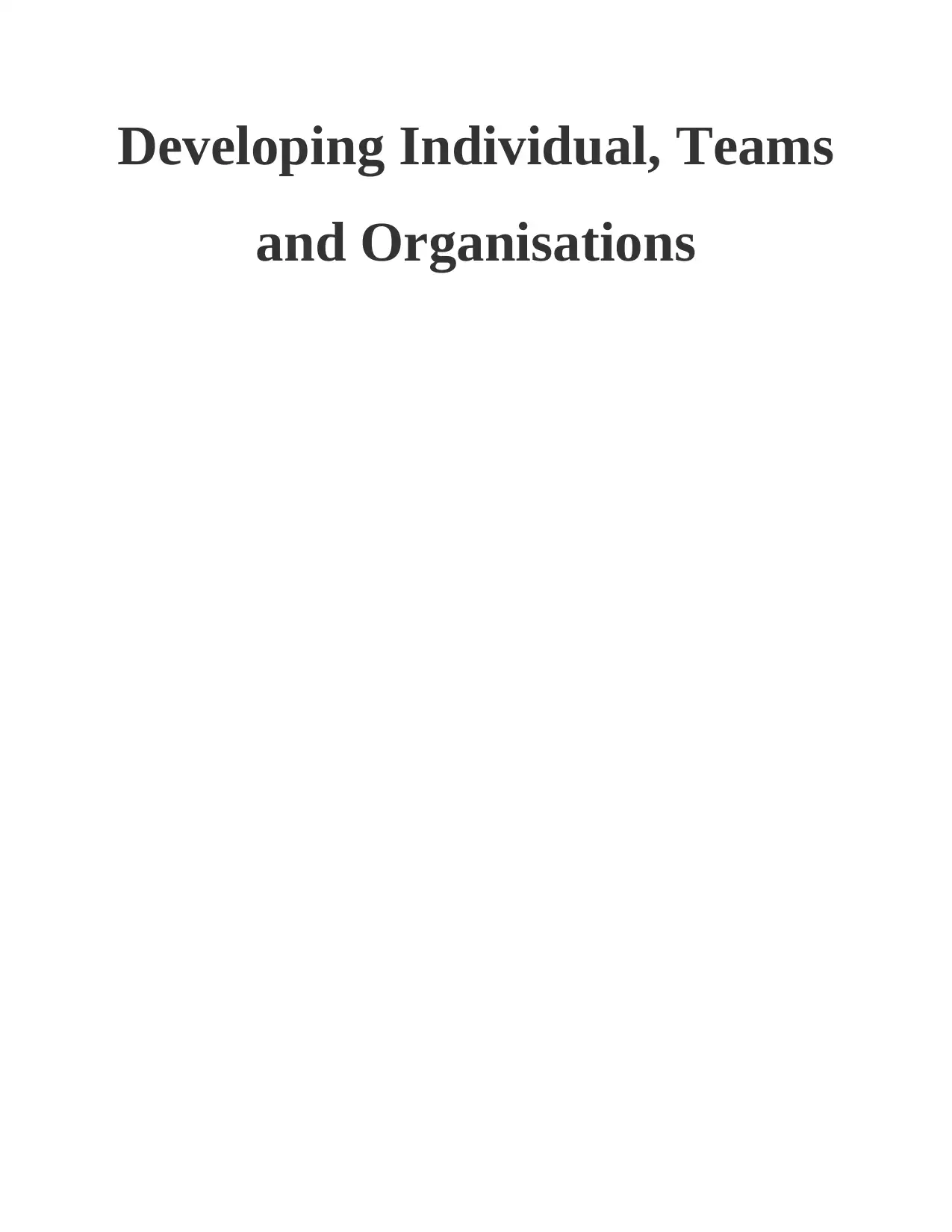
Developing Individual, Teams
and Organisations
and Organisations

⊘ This is a preview!⊘
Do you want full access?
Subscribe today to unlock all pages.

Trusted by 1+ million students worldwide
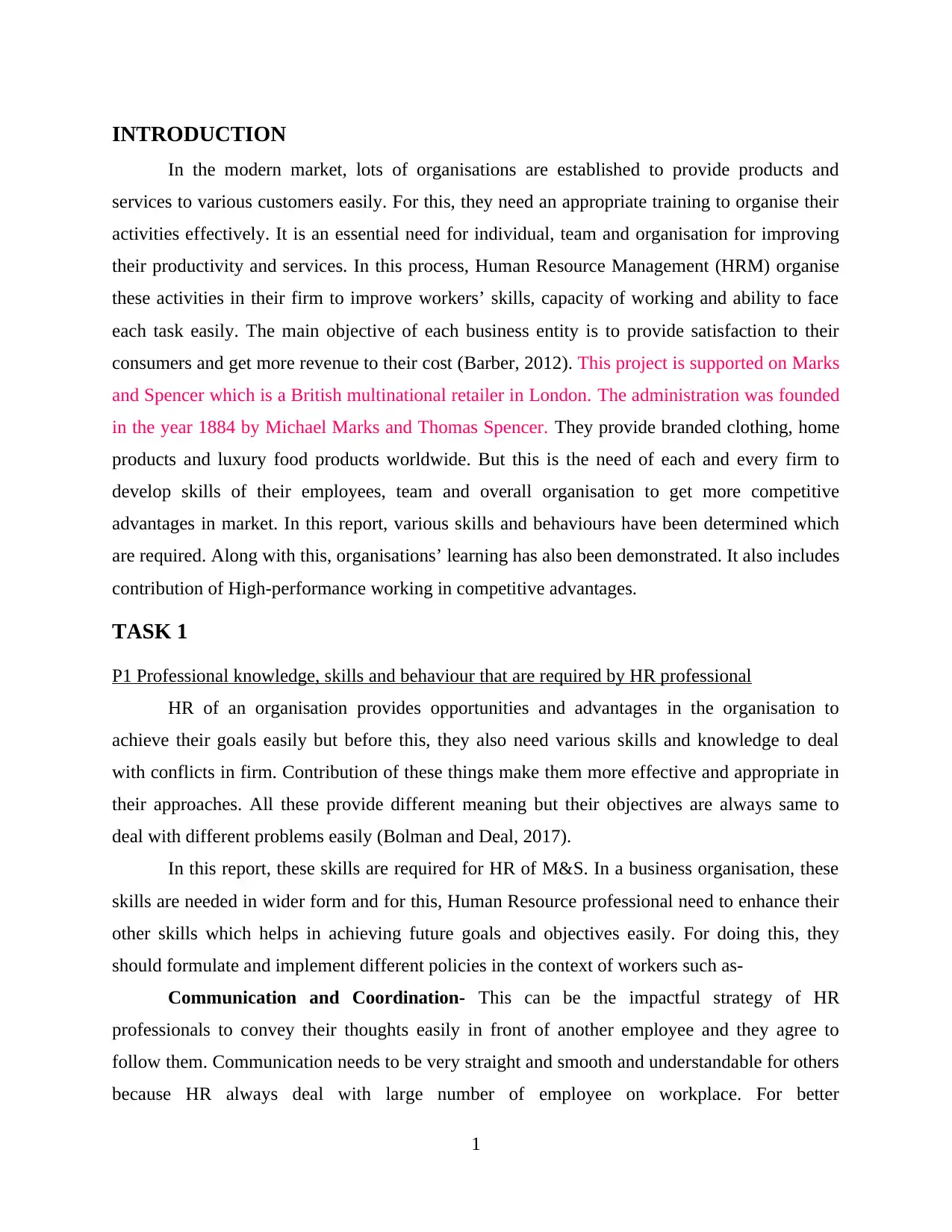
INTRODUCTION
In the modern market, lots of organisations are established to provide products and
services to various customers easily. For this, they need an appropriate training to organise their
activities effectively. It is an essential need for individual, team and organisation for improving
their productivity and services. In this process, Human Resource Management (HRM) organise
these activities in their firm to improve workers’ skills, capacity of working and ability to face
each task easily. The main objective of each business entity is to provide satisfaction to their
consumers and get more revenue to their cost (Barber, 2012). This project is supported on Marks
and Spencer which is a British multinational retailer in London. The administration was founded
in the year 1884 by Michael Marks and Thomas Spencer. They provide branded clothing, home
products and luxury food products worldwide. But this is the need of each and every firm to
develop skills of their employees, team and overall organisation to get more competitive
advantages in market. In this report, various skills and behaviours have been determined which
are required. Along with this, organisations’ learning has also been demonstrated. It also includes
contribution of High-performance working in competitive advantages.
TASK 1
P1 Professional knowledge, skills and behaviour that are required by HR professional
HR of an organisation provides opportunities and advantages in the organisation to
achieve their goals easily but before this, they also need various skills and knowledge to deal
with conflicts in firm. Contribution of these things make them more effective and appropriate in
their approaches. All these provide different meaning but their objectives are always same to
deal with different problems easily (Bolman and Deal, 2017).
In this report, these skills are required for HR of M&S. In a business organisation, these
skills are needed in wider form and for this, Human Resource professional need to enhance their
other skills which helps in achieving future goals and objectives easily. For doing this, they
should formulate and implement different policies in the context of workers such as-
Communication and Coordination- This can be the impactful strategy of HR
professionals to convey their thoughts easily in front of another employee and they agree to
follow them. Communication needs to be very straight and smooth and understandable for others
because HR always deal with large number of employee on workplace. For better
1
In the modern market, lots of organisations are established to provide products and
services to various customers easily. For this, they need an appropriate training to organise their
activities effectively. It is an essential need for individual, team and organisation for improving
their productivity and services. In this process, Human Resource Management (HRM) organise
these activities in their firm to improve workers’ skills, capacity of working and ability to face
each task easily. The main objective of each business entity is to provide satisfaction to their
consumers and get more revenue to their cost (Barber, 2012). This project is supported on Marks
and Spencer which is a British multinational retailer in London. The administration was founded
in the year 1884 by Michael Marks and Thomas Spencer. They provide branded clothing, home
products and luxury food products worldwide. But this is the need of each and every firm to
develop skills of their employees, team and overall organisation to get more competitive
advantages in market. In this report, various skills and behaviours have been determined which
are required. Along with this, organisations’ learning has also been demonstrated. It also includes
contribution of High-performance working in competitive advantages.
TASK 1
P1 Professional knowledge, skills and behaviour that are required by HR professional
HR of an organisation provides opportunities and advantages in the organisation to
achieve their goals easily but before this, they also need various skills and knowledge to deal
with conflicts in firm. Contribution of these things make them more effective and appropriate in
their approaches. All these provide different meaning but their objectives are always same to
deal with different problems easily (Bolman and Deal, 2017).
In this report, these skills are required for HR of M&S. In a business organisation, these
skills are needed in wider form and for this, Human Resource professional need to enhance their
other skills which helps in achieving future goals and objectives easily. For doing this, they
should formulate and implement different policies in the context of workers such as-
Communication and Coordination- This can be the impactful strategy of HR
professionals to convey their thoughts easily in front of another employee and they agree to
follow them. Communication needs to be very straight and smooth and understandable for others
because HR always deal with large number of employee on workplace. For better
1
Paraphrase This Document
Need a fresh take? Get an instant paraphrase of this document with our AI Paraphraser
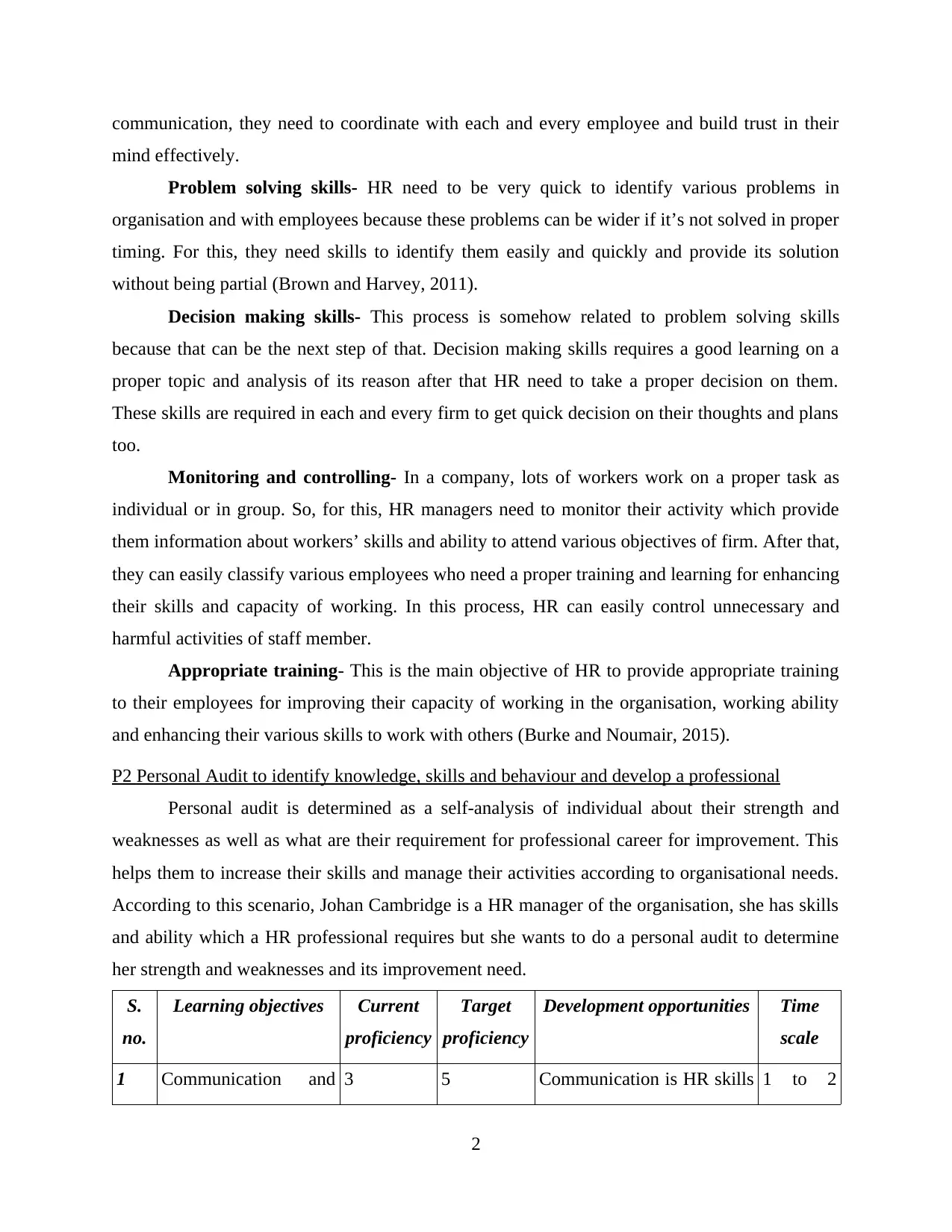
communication, they need to coordinate with each and every employee and build trust in their
mind effectively.
Problem solving skills- HR need to be very quick to identify various problems in
organisation and with employees because these problems can be wider if it’s not solved in proper
timing. For this, they need skills to identify them easily and quickly and provide its solution
without being partial (Brown and Harvey, 2011).
Decision making skills- This process is somehow related to problem solving skills
because that can be the next step of that. Decision making skills requires a good learning on a
proper topic and analysis of its reason after that HR need to take a proper decision on them.
These skills are required in each and every firm to get quick decision on their thoughts and plans
too.
Monitoring and controlling- In a company, lots of workers work on a proper task as
individual or in group. So, for this, HR managers need to monitor their activity which provide
them information about workers’ skills and ability to attend various objectives of firm. After that,
they can easily classify various employees who need a proper training and learning for enhancing
their skills and capacity of working. In this process, HR can easily control unnecessary and
harmful activities of staff member.
Appropriate training- This is the main objective of HR to provide appropriate training
to their employees for improving their capacity of working in the organisation, working ability
and enhancing their various skills to work with others (Burke and Noumair, 2015).
P2 Personal Audit to identify knowledge, skills and behaviour and develop a professional
Personal audit is determined as a self-analysis of individual about their strength and
weaknesses as well as what are their requirement for professional career for improvement. This
helps them to increase their skills and manage their activities according to organisational needs.
According to this scenario, Johan Cambridge is a HR manager of the organisation, she has skills
and ability which a HR professional requires but she wants to do a personal audit to determine
her strength and weaknesses and its improvement need.
S.
no.
Learning objectives Current
proficiency
Target
proficiency
Development opportunities Time
scale
1 Communication and 3 5 Communication is HR skills 1 to 2
2
mind effectively.
Problem solving skills- HR need to be very quick to identify various problems in
organisation and with employees because these problems can be wider if it’s not solved in proper
timing. For this, they need skills to identify them easily and quickly and provide its solution
without being partial (Brown and Harvey, 2011).
Decision making skills- This process is somehow related to problem solving skills
because that can be the next step of that. Decision making skills requires a good learning on a
proper topic and analysis of its reason after that HR need to take a proper decision on them.
These skills are required in each and every firm to get quick decision on their thoughts and plans
too.
Monitoring and controlling- In a company, lots of workers work on a proper task as
individual or in group. So, for this, HR managers need to monitor their activity which provide
them information about workers’ skills and ability to attend various objectives of firm. After that,
they can easily classify various employees who need a proper training and learning for enhancing
their skills and capacity of working. In this process, HR can easily control unnecessary and
harmful activities of staff member.
Appropriate training- This is the main objective of HR to provide appropriate training
to their employees for improving their capacity of working in the organisation, working ability
and enhancing their various skills to work with others (Burke and Noumair, 2015).
P2 Personal Audit to identify knowledge, skills and behaviour and develop a professional
Personal audit is determined as a self-analysis of individual about their strength and
weaknesses as well as what are their requirement for professional career for improvement. This
helps them to increase their skills and manage their activities according to organisational needs.
According to this scenario, Johan Cambridge is a HR manager of the organisation, she has skills
and ability which a HR professional requires but she wants to do a personal audit to determine
her strength and weaknesses and its improvement need.
S.
no.
Learning objectives Current
proficiency
Target
proficiency
Development opportunities Time
scale
1 Communication and 3 5 Communication is HR skills 1 to 2
2
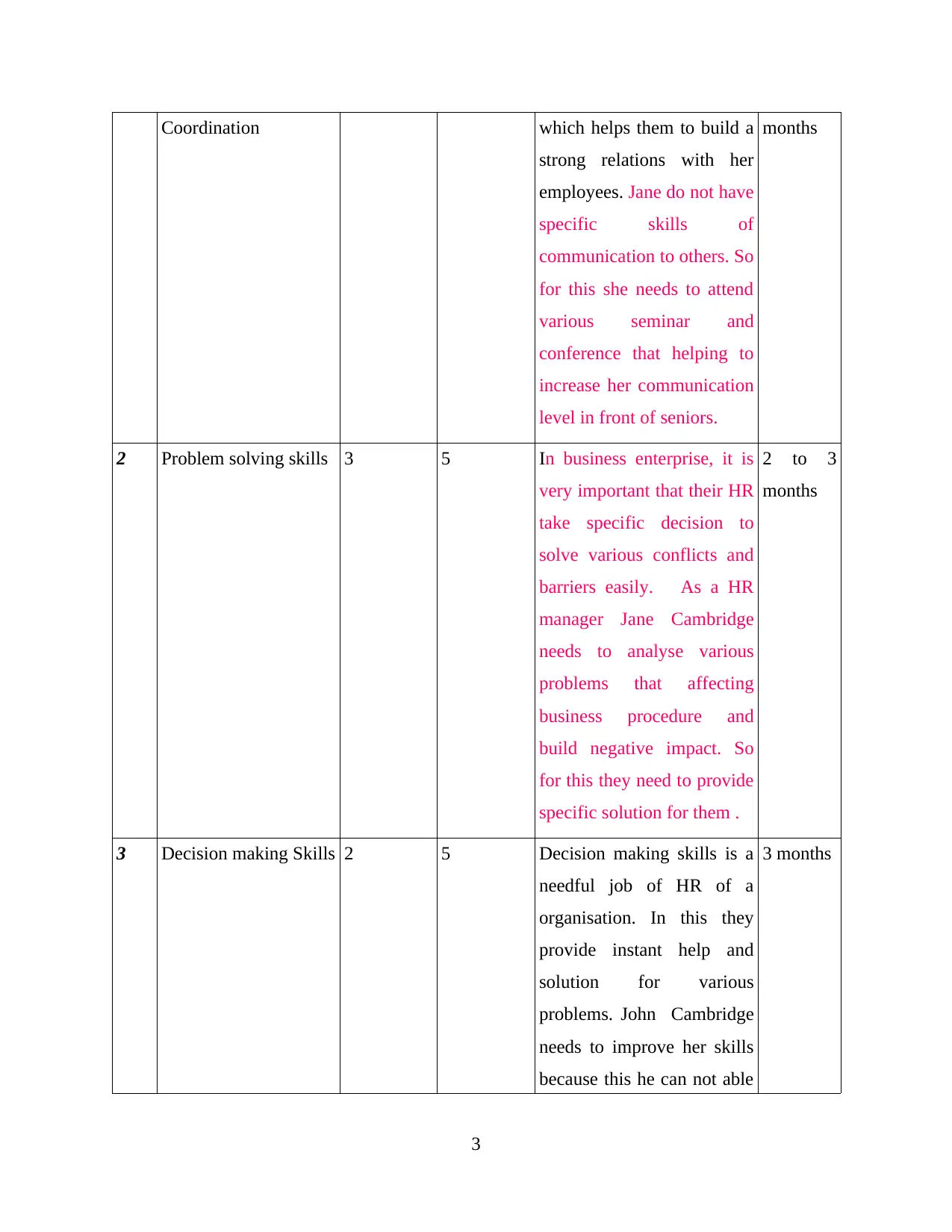
Coordination which helps them to build a
strong relations with her
employees. Jane do not have
specific skills of
communication to others. So
for this she needs to attend
various seminar and
conference that helping to
increase her communication
level in front of seniors.
months
2 Problem solving skills 3 5 In business enterprise, it is
very important that their HR
take specific decision to
solve various conflicts and
barriers easily. As a HR
manager Jane Cambridge
needs to analyse various
problems that affecting
business procedure and
build negative impact. So
for this they need to provide
specific solution for them .
2 to 3
months
3 Decision making Skills 2 5 Decision making skills is a
needful job of HR of a
organisation. In this they
provide instant help and
solution for various
problems. John Cambridge
needs to improve her skills
because this he can not able
3 months
3
strong relations with her
employees. Jane do not have
specific skills of
communication to others. So
for this she needs to attend
various seminar and
conference that helping to
increase her communication
level in front of seniors.
months
2 Problem solving skills 3 5 In business enterprise, it is
very important that their HR
take specific decision to
solve various conflicts and
barriers easily. As a HR
manager Jane Cambridge
needs to analyse various
problems that affecting
business procedure and
build negative impact. So
for this they need to provide
specific solution for them .
2 to 3
months
3 Decision making Skills 2 5 Decision making skills is a
needful job of HR of a
organisation. In this they
provide instant help and
solution for various
problems. John Cambridge
needs to improve her skills
because this he can not able
3 months
3
⊘ This is a preview!⊘
Do you want full access?
Subscribe today to unlock all pages.

Trusted by 1+ million students worldwide
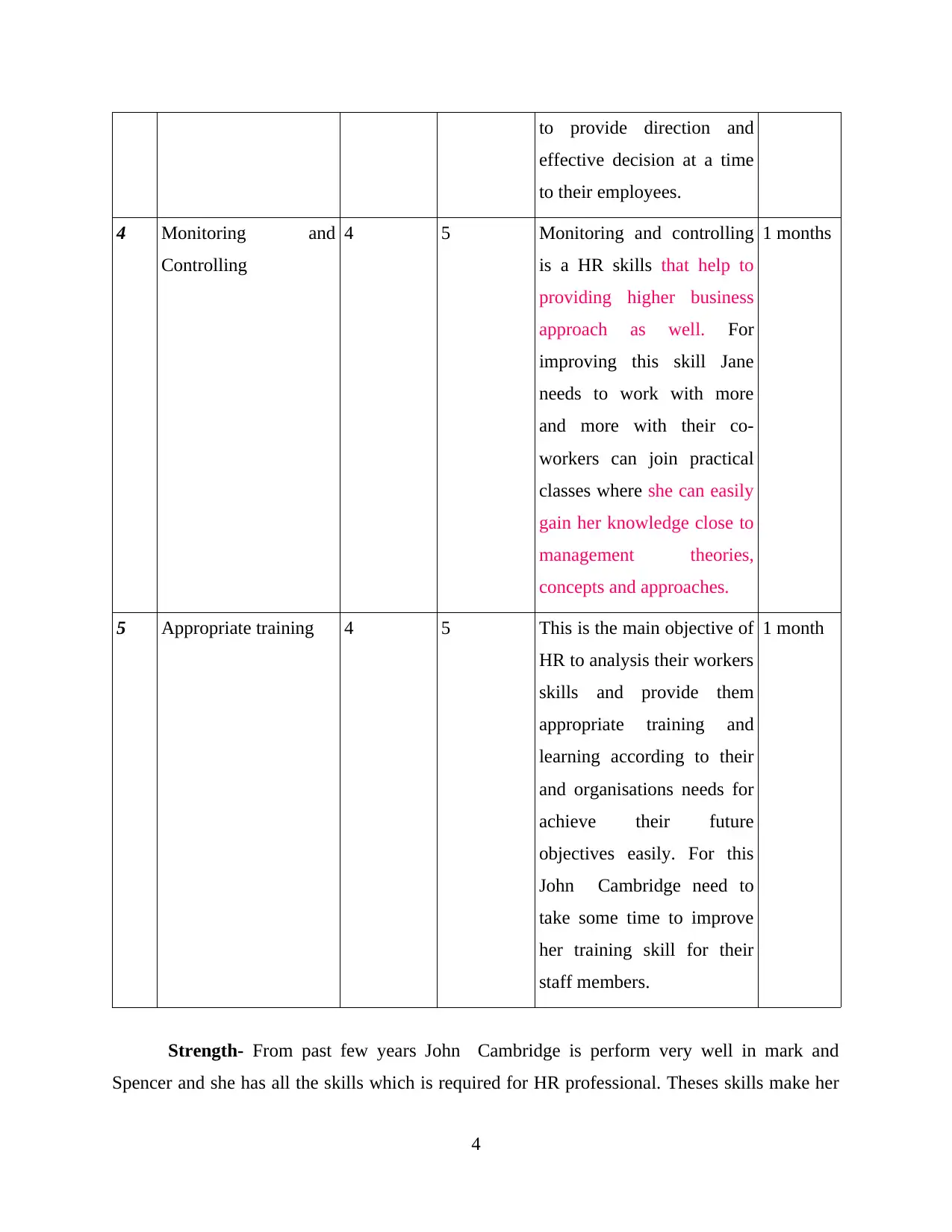
to provide direction and
effective decision at a time
to their employees.
4 Monitoring and
Controlling
4 5 Monitoring and controlling
is a HR skills that help to
providing higher business
approach as well. For
improving this skill Jane
needs to work with more
and more with their co-
workers can join practical
classes where she can easily
gain her knowledge close to
management theories,
concepts and approaches.
1 months
5 Appropriate training 4 5 This is the main objective of
HR to analysis their workers
skills and provide them
appropriate training and
learning according to their
and organisations needs for
achieve their future
objectives easily. For this
John Cambridge need to
take some time to improve
her training skill for their
staff members.
1 month
Strength- From past few years John Cambridge is perform very well in mark and
Spencer and she has all the skills which is required for HR professional. Theses skills make her
4
effective decision at a time
to their employees.
4 Monitoring and
Controlling
4 5 Monitoring and controlling
is a HR skills that help to
providing higher business
approach as well. For
improving this skill Jane
needs to work with more
and more with their co-
workers can join practical
classes where she can easily
gain her knowledge close to
management theories,
concepts and approaches.
1 months
5 Appropriate training 4 5 This is the main objective of
HR to analysis their workers
skills and provide them
appropriate training and
learning according to their
and organisations needs for
achieve their future
objectives easily. For this
John Cambridge need to
take some time to improve
her training skill for their
staff members.
1 month
Strength- From past few years John Cambridge is perform very well in mark and
Spencer and she has all the skills which is required for HR professional. Theses skills make her
4
Paraphrase This Document
Need a fresh take? Get an instant paraphrase of this document with our AI Paraphraser
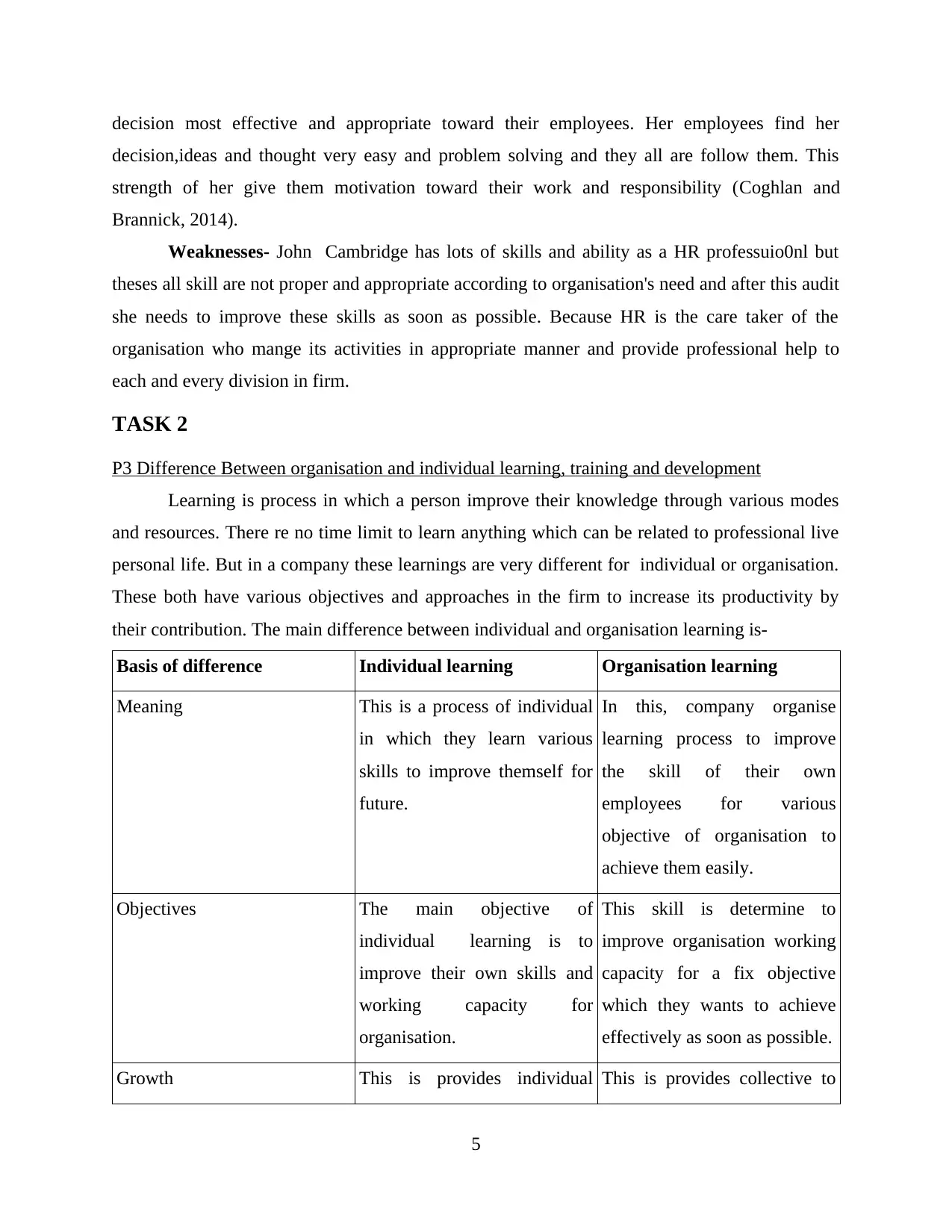
decision most effective and appropriate toward their employees. Her employees find her
decision,ideas and thought very easy and problem solving and they all are follow them. This
strength of her give them motivation toward their work and responsibility (Coghlan and
Brannick, 2014).
Weaknesses- John Cambridge has lots of skills and ability as a HR professuio0nl but
theses all skill are not proper and appropriate according to organisation's need and after this audit
she needs to improve these skills as soon as possible. Because HR is the care taker of the
organisation who mange its activities in appropriate manner and provide professional help to
each and every division in firm.
TASK 2
P3 Difference Between organisation and individual learning, training and development
Learning is process in which a person improve their knowledge through various modes
and resources. There re no time limit to learn anything which can be related to professional live
personal life. But in a company these learnings are very different for individual or organisation.
These both have various objectives and approaches in the firm to increase its productivity by
their contribution. The main difference between individual and organisation learning is-
Basis of difference Individual learning Organisation learning
Meaning This is a process of individual
in which they learn various
skills to improve themself for
future.
In this, company organise
learning process to improve
the skill of their own
employees for various
objective of organisation to
achieve them easily.
Objectives The main objective of
individual learning is to
improve their own skills and
working capacity for
organisation.
This skill is determine to
improve organisation working
capacity for a fix objective
which they wants to achieve
effectively as soon as possible.
Growth This is provides individual This is provides collective to
5
decision,ideas and thought very easy and problem solving and they all are follow them. This
strength of her give them motivation toward their work and responsibility (Coghlan and
Brannick, 2014).
Weaknesses- John Cambridge has lots of skills and ability as a HR professuio0nl but
theses all skill are not proper and appropriate according to organisation's need and after this audit
she needs to improve these skills as soon as possible. Because HR is the care taker of the
organisation who mange its activities in appropriate manner and provide professional help to
each and every division in firm.
TASK 2
P3 Difference Between organisation and individual learning, training and development
Learning is process in which a person improve their knowledge through various modes
and resources. There re no time limit to learn anything which can be related to professional live
personal life. But in a company these learnings are very different for individual or organisation.
These both have various objectives and approaches in the firm to increase its productivity by
their contribution. The main difference between individual and organisation learning is-
Basis of difference Individual learning Organisation learning
Meaning This is a process of individual
in which they learn various
skills to improve themself for
future.
In this, company organise
learning process to improve
the skill of their own
employees for various
objective of organisation to
achieve them easily.
Objectives The main objective of
individual learning is to
improve their own skills and
working capacity for
organisation.
This skill is determine to
improve organisation working
capacity for a fix objective
which they wants to achieve
effectively as soon as possible.
Growth This is provides individual This is provides collective to
5
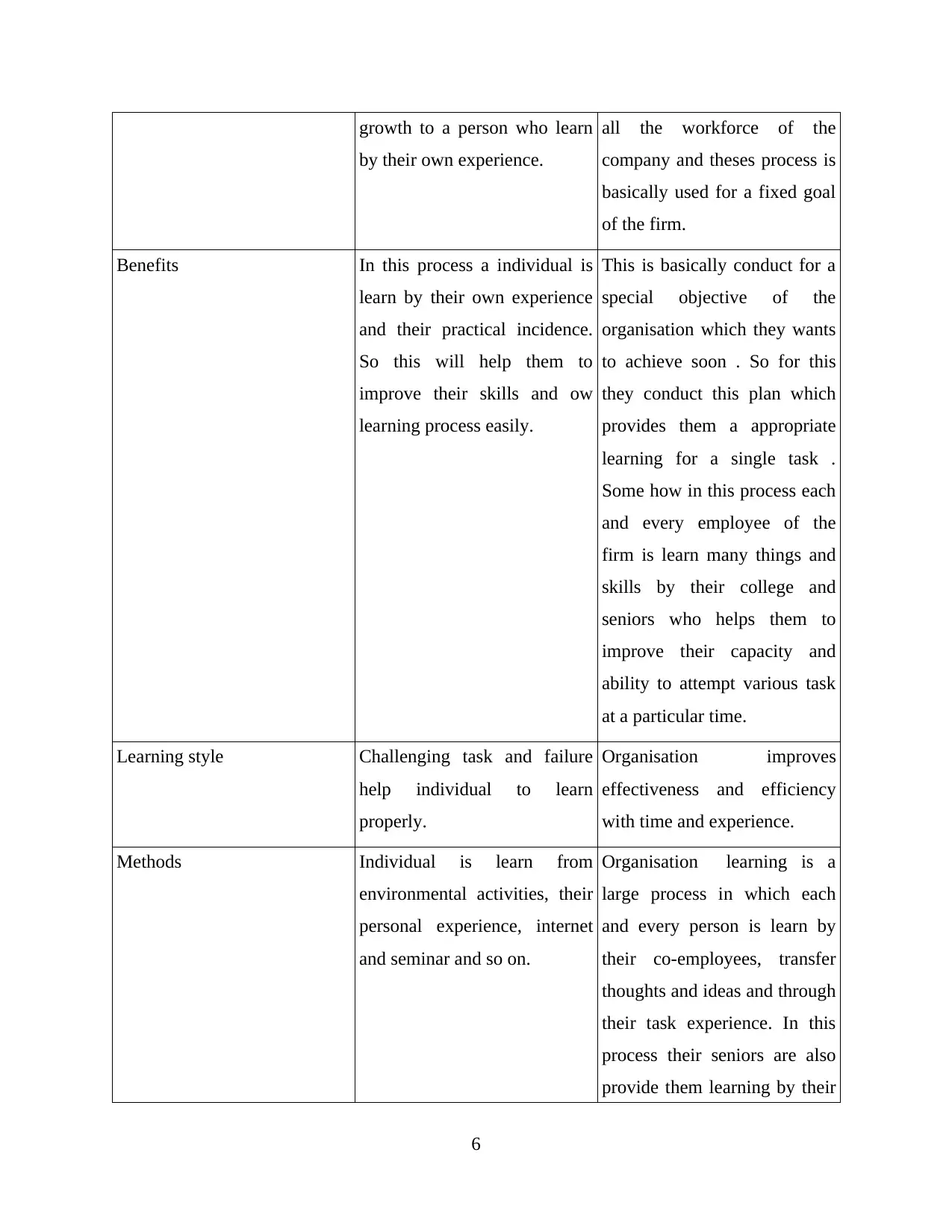
growth to a person who learn
by their own experience.
all the workforce of the
company and theses process is
basically used for a fixed goal
of the firm.
Benefits In this process a individual is
learn by their own experience
and their practical incidence.
So this will help them to
improve their skills and ow
learning process easily.
This is basically conduct for a
special objective of the
organisation which they wants
to achieve soon . So for this
they conduct this plan which
provides them a appropriate
learning for a single task .
Some how in this process each
and every employee of the
firm is learn many things and
skills by their college and
seniors who helps them to
improve their capacity and
ability to attempt various task
at a particular time.
Learning style Challenging task and failure
help individual to learn
properly.
Organisation improves
effectiveness and efficiency
with time and experience.
Methods Individual is learn from
environmental activities, their
personal experience, internet
and seminar and so on.
Organisation learning is a
large process in which each
and every person is learn by
their co-employees, transfer
thoughts and ideas and through
their task experience. In this
process their seniors are also
provide them learning by their
6
by their own experience.
all the workforce of the
company and theses process is
basically used for a fixed goal
of the firm.
Benefits In this process a individual is
learn by their own experience
and their practical incidence.
So this will help them to
improve their skills and ow
learning process easily.
This is basically conduct for a
special objective of the
organisation which they wants
to achieve soon . So for this
they conduct this plan which
provides them a appropriate
learning for a single task .
Some how in this process each
and every employee of the
firm is learn many things and
skills by their college and
seniors who helps them to
improve their capacity and
ability to attempt various task
at a particular time.
Learning style Challenging task and failure
help individual to learn
properly.
Organisation improves
effectiveness and efficiency
with time and experience.
Methods Individual is learn from
environmental activities, their
personal experience, internet
and seminar and so on.
Organisation learning is a
large process in which each
and every person is learn by
their co-employees, transfer
thoughts and ideas and through
their task experience. In this
process their seniors are also
provide them learning by their
6
⊘ This is a preview!⊘
Do you want full access?
Subscribe today to unlock all pages.

Trusted by 1+ million students worldwide
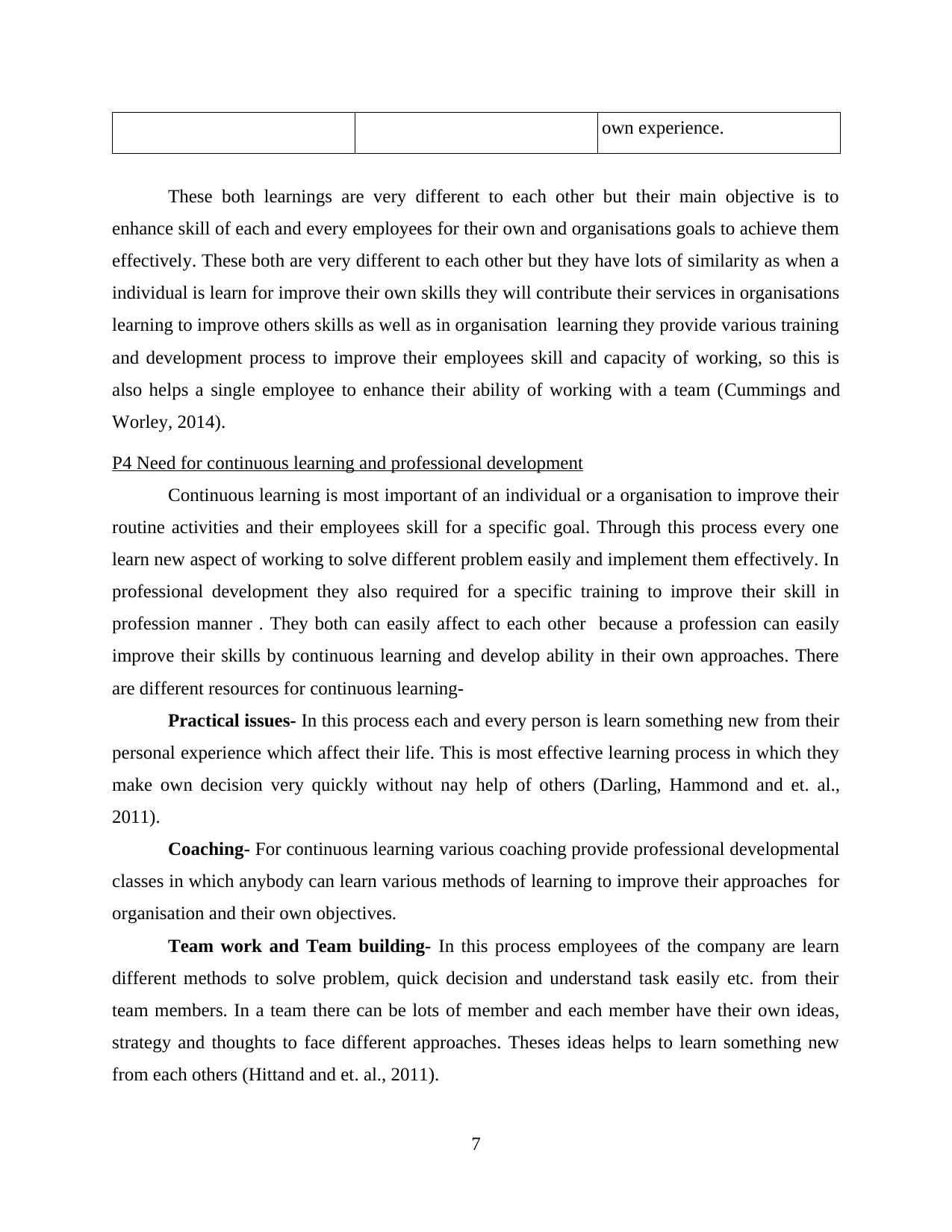
own experience.
These both learnings are very different to each other but their main objective is to
enhance skill of each and every employees for their own and organisations goals to achieve them
effectively. These both are very different to each other but they have lots of similarity as when a
individual is learn for improve their own skills they will contribute their services in organisations
learning to improve others skills as well as in organisation learning they provide various training
and development process to improve their employees skill and capacity of working, so this is
also helps a single employee to enhance their ability of working with a team (Cummings and
Worley, 2014).
P4 Need for continuous learning and professional development
Continuous learning is most important of an individual or a organisation to improve their
routine activities and their employees skill for a specific goal. Through this process every one
learn new aspect of working to solve different problem easily and implement them effectively. In
professional development they also required for a specific training to improve their skill in
profession manner . They both can easily affect to each other because a profession can easily
improve their skills by continuous learning and develop ability in their own approaches. There
are different resources for continuous learning-
Practical issues- In this process each and every person is learn something new from their
personal experience which affect their life. This is most effective learning process in which they
make own decision very quickly without nay help of others (Darling, Hammond and et. al.,
2011).
Coaching- For continuous learning various coaching provide professional developmental
classes in which anybody can learn various methods of learning to improve their approaches for
organisation and their own objectives.
Team work and Team building- In this process employees of the company are learn
different methods to solve problem, quick decision and understand task easily etc. from their
team members. In a team there can be lots of member and each member have their own ideas,
strategy and thoughts to face different approaches. Theses ideas helps to learn something new
from each others (Hittand and et. al., 2011).
7
These both learnings are very different to each other but their main objective is to
enhance skill of each and every employees for their own and organisations goals to achieve them
effectively. These both are very different to each other but they have lots of similarity as when a
individual is learn for improve their own skills they will contribute their services in organisations
learning to improve others skills as well as in organisation learning they provide various training
and development process to improve their employees skill and capacity of working, so this is
also helps a single employee to enhance their ability of working with a team (Cummings and
Worley, 2014).
P4 Need for continuous learning and professional development
Continuous learning is most important of an individual or a organisation to improve their
routine activities and their employees skill for a specific goal. Through this process every one
learn new aspect of working to solve different problem easily and implement them effectively. In
professional development they also required for a specific training to improve their skill in
profession manner . They both can easily affect to each other because a profession can easily
improve their skills by continuous learning and develop ability in their own approaches. There
are different resources for continuous learning-
Practical issues- In this process each and every person is learn something new from their
personal experience which affect their life. This is most effective learning process in which they
make own decision very quickly without nay help of others (Darling, Hammond and et. al.,
2011).
Coaching- For continuous learning various coaching provide professional developmental
classes in which anybody can learn various methods of learning to improve their approaches for
organisation and their own objectives.
Team work and Team building- In this process employees of the company are learn
different methods to solve problem, quick decision and understand task easily etc. from their
team members. In a team there can be lots of member and each member have their own ideas,
strategy and thoughts to face different approaches. Theses ideas helps to learn something new
from each others (Hittand and et. al., 2011).
7
Paraphrase This Document
Need a fresh take? Get an instant paraphrase of this document with our AI Paraphraser
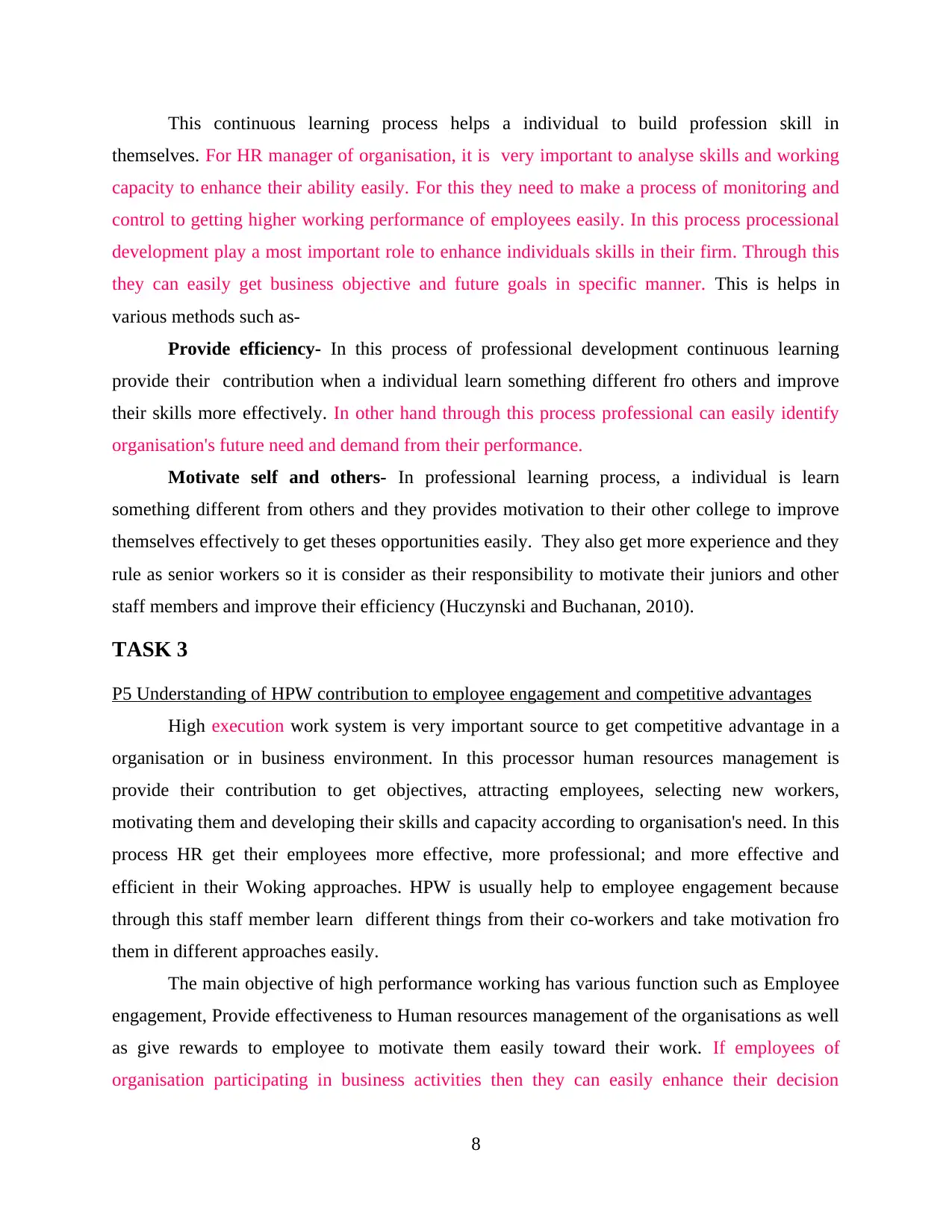
This continuous learning process helps a individual to build profession skill in
themselves. For HR manager of organisation, it is very important to analyse skills and working
capacity to enhance their ability easily. For this they need to make a process of monitoring and
control to getting higher working performance of employees easily. In this process processional
development play a most important role to enhance individuals skills in their firm. Through this
they can easily get business objective and future goals in specific manner. This is helps in
various methods such as-
Provide efficiency- In this process of professional development continuous learning
provide their contribution when a individual learn something different fro others and improve
their skills more effectively. In other hand through this process professional can easily identify
organisation's future need and demand from their performance.
Motivate self and others- In professional learning process, a individual is learn
something different from others and they provides motivation to their other college to improve
themselves effectively to get theses opportunities easily. They also get more experience and they
rule as senior workers so it is consider as their responsibility to motivate their juniors and other
staff members and improve their efficiency (Huczynski and Buchanan, 2010).
TASK 3
P5 Understanding of HPW contribution to employee engagement and competitive advantages
High execution work system is very important source to get competitive advantage in a
organisation or in business environment. In this processor human resources management is
provide their contribution to get objectives, attracting employees, selecting new workers,
motivating them and developing their skills and capacity according to organisation's need. In this
process HR get their employees more effective, more professional; and more effective and
efficient in their Woking approaches. HPW is usually help to employee engagement because
through this staff member learn different things from their co-workers and take motivation fro
them in different approaches easily.
The main objective of high performance working has various function such as Employee
engagement, Provide effectiveness to Human resources management of the organisations as well
as give rewards to employee to motivate them easily toward their work. If employees of
organisation participating in business activities then they can easily enhance their decision
8
themselves. For HR manager of organisation, it is very important to analyse skills and working
capacity to enhance their ability easily. For this they need to make a process of monitoring and
control to getting higher working performance of employees easily. In this process processional
development play a most important role to enhance individuals skills in their firm. Through this
they can easily get business objective and future goals in specific manner. This is helps in
various methods such as-
Provide efficiency- In this process of professional development continuous learning
provide their contribution when a individual learn something different fro others and improve
their skills more effectively. In other hand through this process professional can easily identify
organisation's future need and demand from their performance.
Motivate self and others- In professional learning process, a individual is learn
something different from others and they provides motivation to their other college to improve
themselves effectively to get theses opportunities easily. They also get more experience and they
rule as senior workers so it is consider as their responsibility to motivate their juniors and other
staff members and improve their efficiency (Huczynski and Buchanan, 2010).
TASK 3
P5 Understanding of HPW contribution to employee engagement and competitive advantages
High execution work system is very important source to get competitive advantage in a
organisation or in business environment. In this processor human resources management is
provide their contribution to get objectives, attracting employees, selecting new workers,
motivating them and developing their skills and capacity according to organisation's need. In this
process HR get their employees more effective, more professional; and more effective and
efficient in their Woking approaches. HPW is usually help to employee engagement because
through this staff member learn different things from their co-workers and take motivation fro
them in different approaches easily.
The main objective of high performance working has various function such as Employee
engagement, Provide effectiveness to Human resources management of the organisations as well
as give rewards to employee to motivate them easily toward their work. If employees of
organisation participating in business activities then they can easily enhance their decision
8
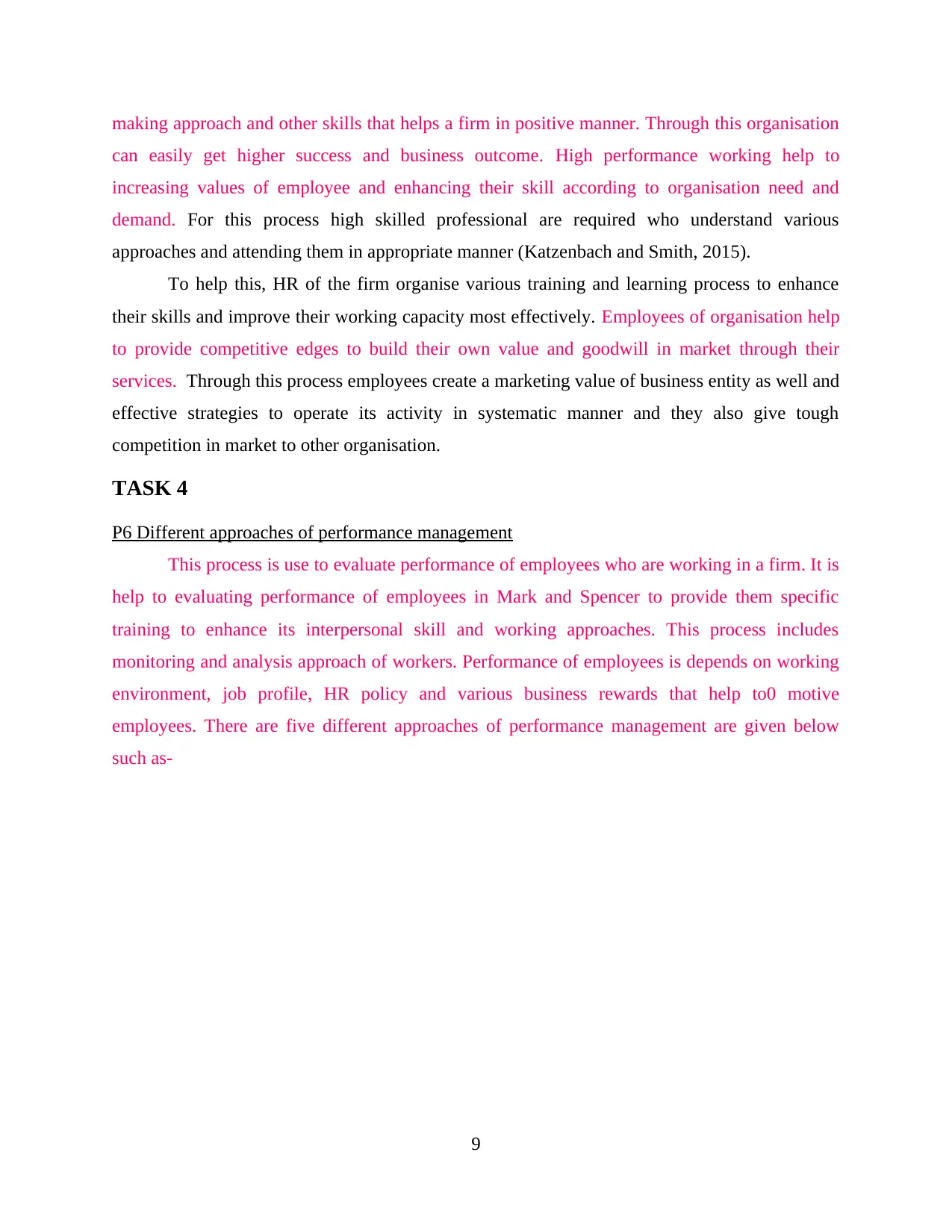
making approach and other skills that helps a firm in positive manner. Through this organisation
can easily get higher success and business outcome. High performance working help to
increasing values of employee and enhancing their skill according to organisation need and
demand. For this process high skilled professional are required who understand various
approaches and attending them in appropriate manner (Katzenbach and Smith, 2015).
To help this, HR of the firm organise various training and learning process to enhance
their skills and improve their working capacity most effectively. Employees of organisation help
to provide competitive edges to build their own value and goodwill in market through their
services. Through this process employees create a marketing value of business entity as well and
effective strategies to operate its activity in systematic manner and they also give tough
competition in market to other organisation.
TASK 4
P6 Different approaches of performance management
This process is use to evaluate performance of employees who are working in a firm. It is
help to evaluating performance of employees in Mark and Spencer to provide them specific
training to enhance its interpersonal skill and working approaches. This process includes
monitoring and analysis approach of workers. Performance of employees is depends on working
environment, job profile, HR policy and various business rewards that help to0 motive
employees. There are five different approaches of performance management are given below
such as-
9
can easily get higher success and business outcome. High performance working help to
increasing values of employee and enhancing their skill according to organisation need and
demand. For this process high skilled professional are required who understand various
approaches and attending them in appropriate manner (Katzenbach and Smith, 2015).
To help this, HR of the firm organise various training and learning process to enhance
their skills and improve their working capacity most effectively. Employees of organisation help
to provide competitive edges to build their own value and goodwill in market through their
services. Through this process employees create a marketing value of business entity as well and
effective strategies to operate its activity in systematic manner and they also give tough
competition in market to other organisation.
TASK 4
P6 Different approaches of performance management
This process is use to evaluate performance of employees who are working in a firm. It is
help to evaluating performance of employees in Mark and Spencer to provide them specific
training to enhance its interpersonal skill and working approaches. This process includes
monitoring and analysis approach of workers. Performance of employees is depends on working
environment, job profile, HR policy and various business rewards that help to0 motive
employees. There are five different approaches of performance management are given below
such as-
9
⊘ This is a preview!⊘
Do you want full access?
Subscribe today to unlock all pages.

Trusted by 1+ million students worldwide
1 out of 15
Related Documents
Your All-in-One AI-Powered Toolkit for Academic Success.
+13062052269
info@desklib.com
Available 24*7 on WhatsApp / Email
![[object Object]](/_next/static/media/star-bottom.7253800d.svg)
Unlock your academic potential
Copyright © 2020–2025 A2Z Services. All Rights Reserved. Developed and managed by ZUCOL.





